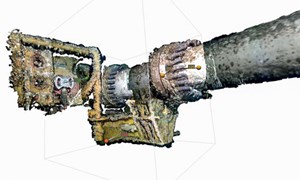East Canada: Newfoundland’s private firms pursue new technologies, fulfill niche opportunities
Optimism and entrepreneurialism are circulating throughout St. John’s, Newfoundland, Canada. Oil prices are up in recent months; operator interest in Newfoundland and Labrador’s (NL) offshore prospects remains high; ongoing projects continue, and recent lease sales have done well.
To capitalize on the improved outlook, a number of locally based firms are developing niche technologies that may offer operators significant efficiencies and reduced costs. This is particularly true for anything related to deepwater activity and subsea facilities. “A key part of the longer-term strategy is the growing use of local R&D,” said Bob Cadigan, president of the Newfoundland & Labrador Oil & Gas Industries Association (NOIA). “That way, we position ourselves like Norway, and refine our capabilities and export solutions to the global market.”
What follows is an extensive sampling, but not complete collection, of companies that are developing new, offshore-related technologies or are taking advantage of logistical opportunities that the NL market affords them.
DEVELOPING AN IPM-DRIVEN ESP
As producing fields deplete, reservoir pressures decrease, resulting in a reduction of a well’s natural flowrate. To combat this reduced flow, and increase the amount of recoverable oil, operators employ various artificial lift techniques, such as gas injection or ESPs. Accordingly, researchers at Memorial University of Newfoundland (MUN) are developing an alternative technology that could be deployed to improve recovery.
ESP problems. ESPs are popular among operators for boosting production from reservoirs. An ESP comprises several impellers connected in tandem. The pump motor assembly is placed inside a casing that is lowered to the downhole reservoir. Power is supplied to the motors from the surface via electrical cables. The oil recovery rate depends on the pressure produced by the ESP and is controlled by varying the operating speed of the driving motors.
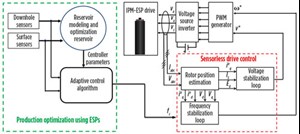
Standard ESPs use submersible induction motors. The challenge posed by induction motors is that they have poor reliability and efficiency. And the total intervention cost to replace or repair an ESP unit is millions of dollars. Researchers at MUN believe there is a significant opportunity in the local industry at St. John’s for the development of an enhanced ESP and control system, which is more economical and reliable than the standard technology.
The IPM solution. Thus, Dr. M. A. Rahman, professor and University Research professor, and graduate student Sheikh Rabbi, a PhD candidate in the Department of Electrical & Computer Engineering at MUN, have partnered with local engineering and technical services company, Avalon Controls Ltd., to develop this alternate ESP technology. The new motor will require a specialized control system to adjust pump speeds to changing reservoir conditions without the use of position or speed sensors.
The research team believes that Interior Permanent Magnet (IPM) technology can improve ESP performance by increasing efficiency; lowering power consumption; improving size-to-HP ratio; and enhancing reliability and longevity. The control of IPM motors is more complex than that for induction motors. Unlike induction motors, the IPM motor’s rotor has no starting torque and must be “coaxed” into motion. In land-based applications, this is achieved easily by using a motor position sensor. For ESP applications, however, a sensor-based solution is less practical.
MUN and Avalon Controls are working to combine the IPM-ESP drive with Smart Well technology (Fig. 1), where fiber optic sensors offer downhole condition data in real time. The sensor data are then used to adjust the ESP speed to control oil flow. The team is developing an intelligent, autonomous feedback control algorithm for ESP drive systems, to maximize production and efficiency.
“OUTSIDE THE BOX” SUBSEA SOLUTIONS
Frontier Subsea Inc. (FSI) is a locally owned and operated, specialized subsea engineering and services company, based in Paradise, Newfoundland. The company comprises skilled personnel experienced in the engineering, procurement, construction, installation and operation of subsea and marine facilities. FSI’s key business is focused on the following strategic areas:
- Subsea engineering and design
- Drilling and completions support
- Offshore installation and IRM
- ROV consultancy services, tooling and equipment
- Project management
- Concept development and R&D.
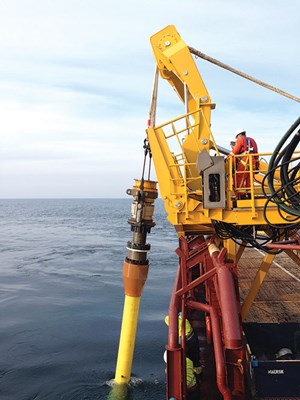
With a strong work ethic, knowledge and local experience, FSI has delivered and provided practical, expedient and cost-effective solutions. These items are delivered against a high standard of quality assurance and quality control, in accordance with its ISO 9001:2008 certified Quality Management System.
While other larger subsea service providers are typically geared to multi-million-dollar development projects, FSI has focused on assisting local operators and contractors with relatively smaller jobs. These projects frequently require specialized technical support and “outside the box” solutions, often working within accelerated timelines. FSI attributes much of its ongoing success to an ability to quickly react to its clients’ needs while also providing innovative and pragmatic solutions.
Over the past four years of operations, Frontier has executed a variety of interesting and challenging projects (Fig. 2) for its local clients, which include operators such as Exxon Mobil, Suncor Energy and Husky Energy. Frontier’s most recent work includes supporting Exxon Mobil’s drilling and completions operations performed on the West Aquarius semisubmersible drilling rig through development of bespoke design, detailed engineering, and fabrication of high-quality, fit-for-purpose equipment.
Frontier also has been integral in supporting Suncor Energy, in concept development and detailed design work associated with the operator’s Terra Nova subsea production system. This has been an effort to provide technical solutions that could improve overall recoverability from Terra Nova oil field.
ADDING ANOTHER DIMENSION TO SUBSEA VIDEO
Whitecap Scientific wants to universalize 3D data. Until recently, subsea teams that needed a 3D perspective required special tools, workflow, and budgets. So, Whitecap Scientific is approaching 3D from a different perspective. It is unlocking the full potential of the subsea industry’s workhorse sensors, standard-definition (and high-definition) cameras. By seamlessly augmenting conventional video with 3D data, the company is giving ROV contractors a reason to dust off their spare cameras, while giving operators access to spatial data during normal operations, all while capturing video as usual.
While overseeing a subsea project in the Baltic Sea, company co-founders, Dr. Sam Bromley and Dr. Richard Charron, became aware of how difficult it is to tackle a complex, 3D problem, when one is limited to a 2D perspective. Thus, the two decided to make 3D data more accessible for subsea teams, offshore and onshore.
The software system, ROV3D, can turn any two SD (or HD) cameras into a 3D scanning and spatial cross-referencing tool. After a brief, 5-min. calibration process, video captured by a camera pair is rendered in real time to present a textured, interactive, 3D model (Fig. 3) of what the cameras are seeing. “Because we generate our 3D models in real time, our clients are able to make more decisions in the field and complete certain tasks with greater efficiency and less uncertainty,” says Bromley.
One of the in-field applications of live 3D is optimizing video coverage during subsea inspections. “We originally thought the live 3D models would identify gaps in video coverage,” says Matt Simms, Whitecap’s sales lead. “But after speaking with operators, we’ve found they’re just as interested in reducing over-coverage. Because they’re able to watch the 3D model grow as video comes in, inspection teams can use the model to monitor where the cameras have and haven’t looked.”
The value of ROV3D continues back onshore. The software spatially cross-references all of the information associated with each 3D model that it generates. For instance, when an anomaly is identified, it can be noted with a “pin” directly on the 3D asset model, so anyone reviewing the data knows exactly where the issue is located. Rather than spend a lot of time watching video, teams can visually inspect the assets spatially, access and review any notes, and even retrieve source video, directly from the 3D model.
ADVANCED UNDERWATER IMAGING/CAMERAS
SubC Imaging creates advanced underwater imaging systems, including state-of-the-art cameras, lights, lasers and DVR Overlay solutions for easy media management. Since its founding in 2010, this NL firm has developed an international clientele in the offshore energy, ocean sciences, and aerospace and defense sectors, with clients in over 20 countries.
SubC enables its clients to acquire better-quality information in the form of optical imagery, and helps them better manage and use that information for improved decision-making. It has done this in the past with its line of 1Cam HD video/digital stills cameras, and Digital Video Recording/Overlaying systems for use in remotely operated vehicle (ROV) operations, such as underwater inspections.
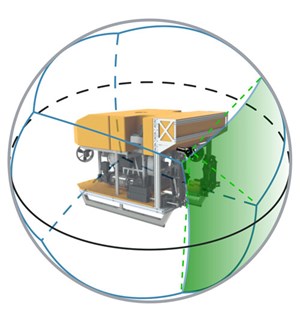
VLS system. In partnership with Dimeye, SubC also created the Video Laser Scan (VLS) system, which combines HD video, lighting and a line laser as a high-accuracy visual and metrology tool. The system can deliver HD visual inspection, as-built 3D CAD modeling, and 3D high-density mapping of deformities and anomalies, ie. cracks, dents and bulges.
New technology. SubC also has two products under development that will soon be available for field testing. The first, the VisionSphere System (Fig. 4), provides an ROV pilot with full visual coverage of a vehicle’s environment by strategically mounting cameras with ultra-wide fields of view (FOV) around the vehicle.The enhanced situational awareness helps mitigate the risk of collision with subsea assets, and the potentially costly repairs that can result. The system improves efficiency, as more of the subsea environment can be captured in a shorter period of time. It also allows for better multi-tasking, since the pilot can focus on running the ROV while the co-pilot focuses on the inspection.
The second, the Rayfin Autonomous Machine Vision System, is designed for use on autonomous underwater vehicles (AUVs), which are being used more frequently to conduct subsea asset inspections and surveys. Built with this platform type in mind, the Rayfin can synchronize AUV data with camera data, and is fully programmable to trigger, based on commands or events (altitude, depth or time). Additional features planned for 2017 include image mosaics, 3D point cloud generation and object recognition.
SIMULATION LOWERS OFFSHORE EQUIPMENT SELECTION RISK
Simulation can make contributions in all phases of offshore development, from assessing risk in the pre-FEED and FEED stages, to increased security during ROV oil field maintenance. GRi Simulations Inc. develops 3D interactive, real-time simulation, modeling and visualization technologies for an extensive range of marine activities, with an emphasis on the development and protection of offshore assets.
GRi’s VROV (Virtual Remotely Operated Vehicle) was first released in 1999 as an ROV simulator for novice pilots learning basic operating techniques. VROV was designed with advanced interactive realism in tether dynamics, multi-beam sonar, and environmental variables. Subsequent iterations have allowed users to add mission planning and rehearsal; scenario creation support; competency assurance; and high-resolution sonar to VROV applications.
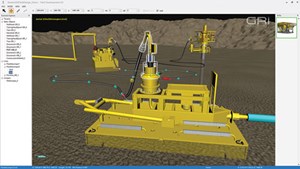
Various analytical tools, including ESRI’s ArcGIS and DSA’s ProteusDS, were integrated with the VROV platform, facilitating geo-referenced offshore component positioning and finite element analysis of systems, respectively. The addition of these applications merged VROV’s pilot training utility with analytical capabilities, which have since been used in planning and implementing oil field layouts and processes, including pipeline repair and riser pull-in operations.
The IDEA-FDK (Interactive Design, Engineering and Analysis–Field Development Kit, Fig. 5) is the second of GRi’s flagship products. It grew out of a demand for a design and visualization tool that could be used to intuitively implement design concepts in a virtual oil and gas field. These virtual fields are composed of the user’s terrain, equipment and operating procedures. Bathymetry data collected and imported from real-world surveys form the basis of the virtual scene, which may then be populated, using 3D equipment models positioned and connected via drag-and-drop functions.
Pipeline, flowline and flying lead systems are examples of equipment that, in an interactive 3D format, can be tested, based on the dynamic properties defined by the user. Throughout the design process, an ROV model may be imported into the scene to interact with equipment in modifiable environmental parameters. The IDEA-FDK’s simulated output, when recorded as a screenshot, video or simulated log file, provides assistance in diverse areas, from collaborative engineering to marketing.
NEW ICE DETECTION FOR RADAR SYSTEMS
During first-quarter 2017, Rutter Inc. will release the most significant update to its flagship radar system, the sigma S6 Ice Navigator, adding advanced ice imaging analysis to it. In addition, Rutter will release the new sigma S6 Ice Defence system, an ice radar system aimed at users, for whom ice management is a serious operational and safety concern when working in areas with sea ice and bergs.
These new sigma S6 systems provide important innovations in both radar image quality and navigational information, expanding current processing capabilities and performance. These innovations provide increased situational awareness to navigators and sea ice observers, thereby improving safety and security for people working in these harsh environments.
One of the new features is the automatic detection and outlining of ridges in ice fields. Ice pressure ridges pose a significant navigational hazard and can easily damage a vessel’s hull. Automatic detection and outlining of the ridge by the sigma S6, showing its location and extents, offers an advantage to a vessel underway and allows the ridges to be avoided more easily.
Another new capability is the detection of icebergs embedded in pack ice. Icebergs, due to irregular geometry, are difficult targets to detect for standard radars, because they can have a low radar profile for their size. The sigma S6 Ice Radar systems can automatically alarm and notify users of icebergs, when they are embedded in pack ice.
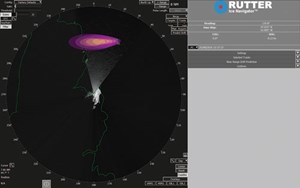
The sigma S6 Ice Navigator and sigma S6 Ice Defence systems also will be able to identify and mark open water leads within an ice floe. Several ice management features are only available with the new sigma S6 Ice Defence system. The automatic outlining and drift tracking of both ice pans and floes will provide a new strategic level of sea ice management. The automatic outlining and tracking of these features by the sigma S6 Ice Defence system will provide a vital tool to ice observers and bridge crews that monitor and deal with these high-risk items.
The sigma S6 Ice Defence system also will offer near-range, ice drift prediction (Fig. 6 ), providing information on future positions of icebergs, bergy bits and growlers, in open water. Bergy bits and growlers pose additional hazards to navigation, compared to the obvious hazards due to larger icebergs. They often are more difficult to detect in higher sea states, and can easily create hull and propulsion system damage.
Two new capabilities available for all Rutter systems are Coastline Masking and the sigma S6 Connect data interface. The Coastline Masking feature incorporates a world coastline map, eliminating false positive targets when operating near land. sigma S6 Connect makes all of a company’s sigma S6 data available through an open standards and data formats interface.
KEEPING FABRICATION, ENGINEERING WITHIN THE PROVINCE
Talon Energy Services provides services and solutions to NL’s oil and gas, resource, and heavy industrial sectors. With a single point of contact for personnel, engineering, fabrication, fabric maintenance, construction, commissioning/start-up, and maintenance services, Talon’s suite of companies offers clients full-service solutions.
The company was incorporated by five principal shareholders in 2003 as Acquaint Personnel Services Inc. But after acquiring or incorporating a number of subsidiaries, the company was renamed Talon Energy Services in February 2010, and the name, Acquaint Contracting Services, was confined to the personnel division. The firm now has headquarters in St. John’s, NL, with a Western Canada office near Edmonton, Alberta.
“We actually formed a lot of our experience in Western Canada,” said Jill Andrews, Talon’s Corporate Services manager. “From there, we pushed hard to get business in eastern Canada.” One of the pieces of business that Talon secured in the last several years is fabrication of the flare boom for Exxon Mobil’s Hebron topsides project. To execute this and other new contracts, a fabrication facility capable of large-scale work would be required, along with skilled workers. At that time, all fabrication facilities on Newfoundland’s East Coast were at capacity, and finding and retaining skilled workers in eastern NL was a struggle, due to the increase in construction happening in the province at that time.
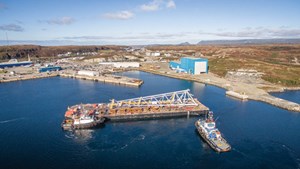
“When Hebron’s work started several years ago, Alberta was still booming, so we were having a hard time finding workers,” explained Andrews. “So, the owners looked at the west side of the island for fabrication facilities. By locating a fabrication facility in Port aux Basques, they solved their two problems, as the area came with a first-class workforce, who were eager to return to work in Newfoundland after spending years working on rotations in Alberta and beyond. The firm then invested $5 million into upgrading and expanding an existing facility in that city, including upgrading of various mechanical and electrical systems; adding of new manufacturing equipment; adding a blast-and-paint operation; and investing in a new quayside at that location.
Confirmation that Talon had done the right thing was the successful fulfillment of the Hebron flare boom contract from Exxon Mobil contractor Worley Parsons, from December 2013 to October 2015. The project involved fabrication, engineering, and outfitting and coating of the flare boom structure, primarily at the Port Aux Basques facility. After its completion, the flare boom was loaded out onto a barge at quayside, Fig. 7.
Thus, Talon has proven to the NL east coast industry, that the west coast, and in particular the Port aux Basques area, can play a key role in the future of the province’s energy projects.
PROVIDING PROVEN TALENT FOR MAJOR PROJECTS
NSB Energy is a technical personnel services company, founded in 1993 in St. John’s, NL. Its mission is to provide clients with personnel who manage successful projects. Specializing in project management and engineering capabilities, the company’s experience is diversified across oil and gas, mining, other energy, and major capital projects.
NSB’s greatest asset is its people, making it the largest personnel firm on Canada’s East Coast. The company has assembled, and maintains, a strong team of individuals who have gained valuable experience on major NL projects. At NSB Energy, a consultant’s knowledge, experience and leadership are unparalleled. This knowledge and experience spans a full range of disciplines, covering all phases of a project. During concept and development, engineering, construction, commissioning, and operations, NSB personnel are there, driving the success. The disciplines covered include Project Management, Project Controls, IM/IT, Contracts & Supply Chain, Construction Management, Commissioning & Completions, Engineering Oversight, Quality Assurance, HSE, and Administration.
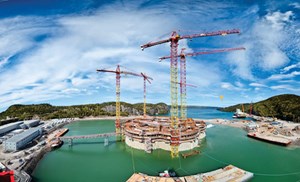
NSB Energy is locally owned and operated, with a proven track record. It maintains a strong network, based on strong relationships within the industry. President and CEO Michael Critch manages the company, offering more than 20 years of experience in oil and gas. As a professional engineer, Critch leads his team in assembling the talented personnel necessary to successfully manage projects across NL. The company is able to fully appreciate and understand its clients’ needs and is well-positioned to leverage its network, to provide key personnel, as required, to solve and service those needs.
NSB personnel are active on all major projects across NL, including the Hebron (Fig. 8), Hibernia, Terra Nova and White Rose field developments, as well as the Lower Churchill hydroelectric project and the Voisey’s Bay nickel mine. In addition, NSB folks are well-versed in offshore drilling and currently work various programs offshore Canada’s East Coast. Once these programs are completed, NSB personnel will be ready to work on the next project.
As a local supplier, the exploration and licensing bid rounds for offshore Newfoundland and Labrador are signs of continuing growth for the company. New operators and projects can mean more opportunities for employment for NSB’s personnel and an opportunity for operators to utilize the expertise of the talented group that the company has assembled.
HELICOPTER SERVICES FOR HARSH ENVIRONMENTS
Operating a helicopter service based in the middle of some of the world’s harshest flying weather offshore NL and Nova Scotia, Cougar Helicopters has developed several strengths. These include innovation, safety-consciousness, and flexibility, which have become watchwords for the company’s highly experienced flight crews, engineers and support staff.
SAR capabilities. These strengths have come into play, in supporting Canada’s offshore oil production while pioneering new methods and equipment for marine search and rescue (SAR). Regarding the latter item, the company has a dedicated Search and Rescue hangar, “where everything has been designed to achieve ‘wheels up’ in 20 min. after we receive a call for help,” said Candace Moakler, the public affairs officer at Cougar. She explained that the firm maintains 24/7/365 coverage for SAR operations, similar to a fire department: sleeping quarters, back-up power generator, gym, kitchen and training facilities are included. The stand-by crew is composed of five crewmen (two pilots, one hoist operator and two rescuemen) ready to board the SAR helicopter at any time. These and additional personnel train about 60 hr/month, said Moakler.
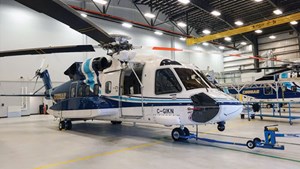
Contract flights to facilities. In addition to its SAR services, Cougar operates contractual shuttle flights between the various fields operated by Hibernia Management & Development Co. (Exxon Mobil), Suncor and Husky in the Jeanne d’Arc basin, as well as out to mobile rigs in that basin and the Flemish Pass area, where Statoil has hit several finds. The firm’s S-92 helicopters’ (Fig. 9) “round trip time to Hibernia is 3 hr, and the distance to the Sea Rose FPSO is 220 nautical miles” said Scott Ferguson, one of Cougar’s pilots. “We can fly as fast as 220 knots, with a total fuel duration capability of 5½ hr.”
Ferguson also noted that these helicopters are quite suitable for the Flemish Pass area. “Depending on the exact site in that area, this is about a 4 ½-to-5-hr round trip. It’s a range of 260 to 300 nautical miles offshore.” In addition to gearing up for regular contractual flights out to rigs in the Flemish Pass, Cougar has been working on its SAR capabilities for the area. “We’re equally ready for any situation in that region, as we are in the Jeanne d’Arc basin,” added Moakler.
The company maintains five line aircraft in St. John’s, plus one dedicated SAR helicopter. In addition, Cougar has two line aircraft assigned to Halifax, Nova Scotia. The firm had its contract to fly workers between its onshore base and several offshore installations extended by six years in second-half 2014. This enabled Cougar to construct a new 17,000-ft2 hangar and 13,000-ft2 administration building, both of which opened several months ago.
MARINE SERVICE BASE GEARS UP FOR MORE SUPPLY VESSELS
While the marine service firm, A. Harvey & Company (AHC), may not be in the business of developing new or niche oilfield technology, it is nonetheless the glue that holds together the offshore supply industry in Newfoundland. And while the global oil market’s doldrums have had their effect on local offshore projects, the firm is not letting that stop it from making necessary improvements, in anticipation of an inevitable activity upturn that is likely to include deepwater work.
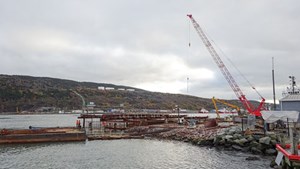
With its five berths still remaining fairly busy in St. John’s harbor, AHC has been expanding its dock space to allow for some spare capacity. “We awarded the contract for two extra berths in June 2015, and construction began this past summer, although significant work didn’t begin until September. The work just finished in December,” said AHC Director of Offshore Operations Geoff Cunningham.
“The addition of the two berths gives us a total of seven, of which six will be fully operational with crane capability,” added Cunningham. “The expansion is to gear up for the deepwater activity that we expect down the line. Something else helping to support those two extra berths is the 12-year work program announced (in second-half 2016) by Exxon Mobil.”
The project that Cunningham refers to is Exxon Mobil’s Eastern Newfoundland Offshore Exploration Drilling Project. (For more details, see the “Activity Update” section toward the end of this article). And there are rumors of additional activity that may be started up later this year by other operators. “This year, 2017, is going to be busy for us,” added Cunningham. “Hebron’s mating of the GBS and topsides occurred in December, rather than January or February, so tow-out may be in May, instead of during the summer.”
ACTIVITY UPDATE
Since our last article (September 2016) in the East Canada series, several newsworthy events have occurred in the Newfoundland offshore market. In August 2016, the NL government, provincial firm Nalcor Energy and Beicip-Franlab announced the results of their latest resource assessment. Through the integration of satellite slick data, 2D long-offset seismic, 3D long-offset seismic and seabed coring, a new Lower Tertiary play trend was identified in the West Orphan basin.
The in-place oil and gas resource potential for this basin has been estimated at 25.5 Bbbl of oil and 20.6 Tcf of gas. This brings the potential identified in the 2015 and 2016 land sale area to 37.5 Bbbl of oil and 133.5 Tcf of gas, covering a mere 4% of the Newfoundland and Labrador offshore. Remarked Jim Keating, executive V.P. for Corporate Services and Offshore Development at Nalcor Energy, “The 3D seismic survey added an additional layer of insight, which has played an essential role in helping us risk reduce key prospects from a 1-in-20 to a globally competitive 1-in-6 chance of success.”
By design, this potential was identified within the area of the Canada-Newfoundland and Labrador Offshore Petroleum Board’s (C-NLOPB) 2016 Eastern Newfoundland Call for Bids. This offering comprised 13 parcels and 2.9 million hectares. A second, concurrent call for bids, covering a portion of the Jeanne d’Arc region, offered three parcels and 354,552 hectares. Thus, on Nov. 9, 2016, the C-NLOPB and Nalcor Energy announced that six of the 13 parcels in the Eastern Newfoundland grouping were awarded to companies bidding a grand total of about $514 million.
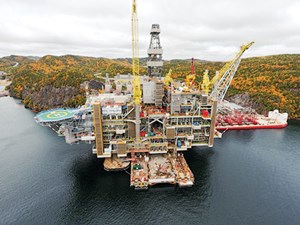
And in the Jeanne d’Arc grouping, two of the three parcels attracted winning bids from Husky Oil, totaling just over $244 million. This was the province’s second scheduled licensing round. Future licensing rounds scheduled through 2020 will follow the same process, with detailed resource assessments being conducted and released prior to bids closing.
Meanwhile, Exxon Mobil said in September 2016 that it would pursue its Eastern Newfoundland Offshore Exploration Drilling Project. This 12-year exploration plan would include drilling up to 35 wells, beginning in 2018. The drilling would focus on areas within exploration licenses that Exxon Mobil and its partners already hold.
Hebron development progress. Last, but certainly not least, the topsides of Exxon Mobil’s Hebron field platform were mated with the concrete gravity based structure (GBS) on Dec. 13 and 14, 2016 (Fig. 11). To achieve the joining of the two components, Exxon Mobil lifted the topsides onto two barges. They were than floated into the harbor at the Bull Arm facility, over top of the GBS. Hook-up and commissioning of the completed platform will continue until the middle of 2017, when the structure will be towed out to the Hebron field site. Exxon Mobil still expects to produce first oil in late 2017.
“This is a very key milestone for the project,” said NOIA’s Cadigan. He said that this is just one of several pieces of good news for the Newfoundland industry that will form the basis of discussion at NOIA’s next annual conference in St. John’s, June 19-22 at the city’s Convention Centre. “And the most recent reserves assessment was game-changing,” continued Cadigan, “because now there’s potential for giant fields here, particularly in the turbidite plays. If things hold together the way that they did in Brazil, then we’ll have a string of giant fields here.”
Avoiding problems. Yet, there are still reasons for concern in the local industry, added Cadigan. “We’re awash in potential, but it’s being taken over by a wave of cost-cutting. One of the things that’s important is the impact of downward pressure [from operators] and the effects on local companies. We’ve seen companies here that date back to Hibernia [field’s development] that have been displaced by all the cost-cutting and commoditization of equipment and services. This is the biggest issue in the minds of our members. It’s not that they’re not competitive, it’s just that there’s this drive toward the lowest cost, driving self-performance by Tier 1 contractors.
“I wouldn’t say that the operators are being unreasonable, but things like reverse auctions are not productive or sustainable,” explained Cadigan. “And on some of the work, if the local companies lose it now, they may stay shut out in the future—just when we’re really hitting our prospectivity, we’re maybe losing capacity.”
Cadigan said that Newfoundland has great local capacity, through locally placed global and indigenous firms, in mission-critical areas like subsea engineering (as evidenced by some of the technology in this article). “Yet, the pressures of the international market are working to evaporate capacity,” he lamented. “As the large, global service companies react to pressures to reduce cost, they tend to pull back their capacities at the very same time.
“We’ve got all these short-term actions going on, when what we really need is long-term thinking.” He said that he would like to see the industry and government adopt NOIA’s vision for the NL province’s oil and gas future, entitled Redefining Oil, which was released in November 2015. Looking to foster continuous development and growth, the plan calls for “industry-wide collaboration to set a new course, focused on local participation, technology transfer, technology development and mechanisms to achieve results.” ![]()

- Prices and governmental policies combine to stymie Canadian upstream growth (February 2024)
- U.S. producing gas wells increase despite low prices (February 2024)
- U.S. drilling: More of the same expected (February 2024)
- U.S. oil and natural gas production hits record highs (February 2024)
- U.S. upstream muddles along, with an eye toward 2024 (September 2023)
- Canada's upstream soldiers on despite governmental interference (September 2023)

